The primeval beech forests of the Carpathians and other regions in Europe are the last remaining parts of a huge beech forest, that once covered a large part of Europe. The ancient forests are indispensable to understanding the history and the evolution of the common beech (Fagus sylvatica) in the Northern Hemisphere. This ancient beech forests also holds the largest, the tallest and oldest beeches in the world. The Ancient Beech Forests of Germany are situated in five protected areas: National Park Kellerwald-Edersee in Hesse, National Park Hainich in Thüringia, National Park Grumsiner Forst in Brandenburg, National Park Jasmund and National Park Müritz in Mecklenburg-West-Pomerania. The Ancient Beech Forests of Germany gained the status as a UNESCO World Heritage in 2011 as an extension of the UNESCO World Heritage Site Primeval Beech Forests of Slovakia and Ukraine, already inscribed in 2007. A number of new locations were inscribed in 2017 and in 2021. Today, the natural transboundary World Heritage Site stretches over eighteen countries, it was inscribed on the UNESCO World Heritage List as: Ancient and Primeval Beech Forests of the Carpathians and other regions in Europe. Together, the protected Ancient Beech Forests form a unique natural UNESCO World Heritage Site. World Heritage Art: Primeval beech forest and Ancient Beech Forest
www.werelderfgoedfotos.nl © Copyright World Heritage Photos
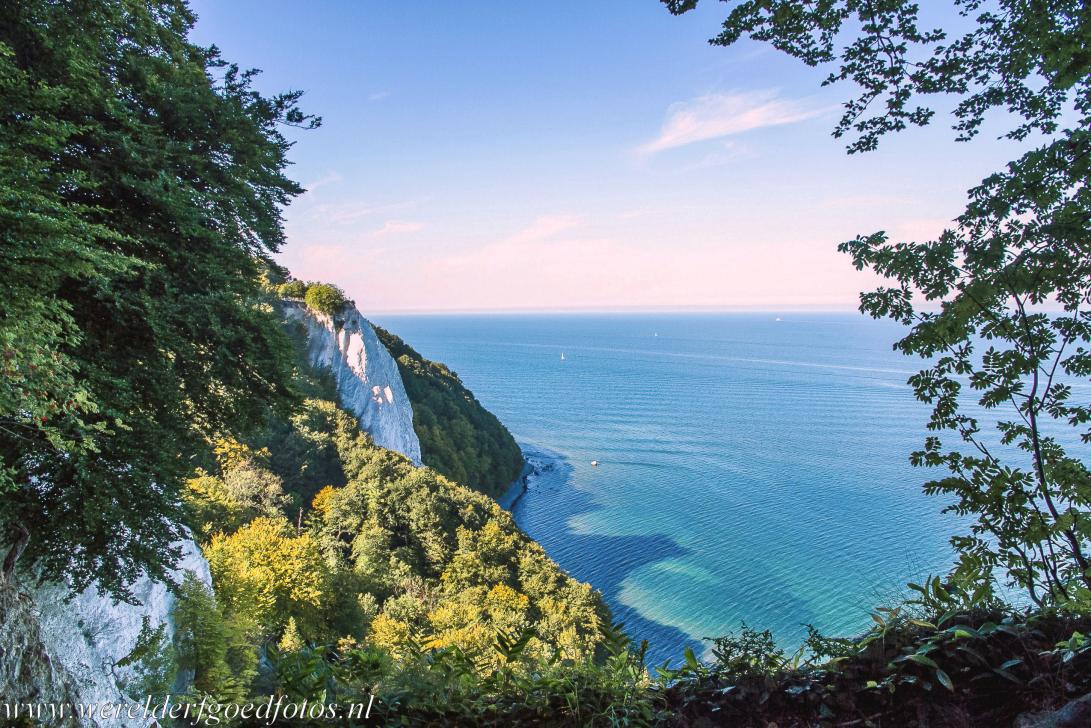
Jasmund National Park: Der Königsstuhl, the King's Chair, viewed from the Victoria Sight. The Königsstuhl is a 118-meter-high chalk cliff on the island of Rügen, the chalk cliff is a renowned landmark and known for its imposing height and amazing views over the Baltic Sea. The King's Chair is surrounded by ancient and primeval beech forests, these beech forests are a notable feature of Jasmund National Park, along with the chalk cliffs. The Jasmund National Park is the smallest national park of Germany, but the most visited due to it chalk cliffs and beech forests.

Jasmund National Park: Der Königsstuhl, the King's Chair, viewed from the Victoria Sight. The Königsstuhl is a 118-meter-high chalk cliff on the island of Rügen, the chalk cliff is a renowned landmark and known for its imposing height and amazing views over the Baltic Sea. The King's Chair is surrounded by ancient and primeval beech forests, these beech forests are a notable feature of Jasmund National Park, along with the chalk cliffs. The Jasmund National Park is the smallest national park of Germany, but the most visited due to it chalk cliffs and beech forests.
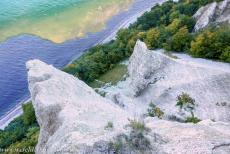
Jasmund National Park: The Victoria Sicht, Victoria Sight, viewed from the Wissower Klinken on the island of Rügen. The observation point is named after a Prussian princess. A hike to the Victoria Sicht leads through prehistoric and ancient beech forests. From the Victoria Sicht, you can also see the island's most famous chalk cliff, the Königsstuhl, the King's Chair. The Wissower Klinken are the imposing chalk cliffs along the coast of Rügen. The Wissower Klinken were once higher, but partially collapsed in 2005 due to erosion.
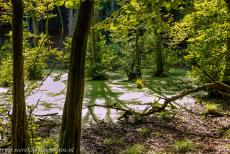
Jasmund National Park: The Black Alder Swamp, one of the swamp-like ponds behind the chalk cliffs. The largest beech forests along the Baltic coast are located on Rügen. Because of their location on the steep chalk cliffs, the forests were difficult to access and have never been logged or used for forestry, they remained in their original state for a long time. The forests in Jasmund National Park consist of about 80 % of beech, the Fagus sylvatica. Other tree species can also be found in the park such as the black alder, the Alnus glutinosa.
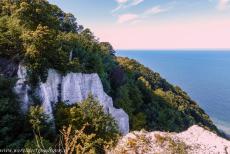
Jasmund National Park, Germany: Der Feuerregenfelsen, the Fire Rain Rock, is a chalk cliff in the Stubbenkammer. The Stubbenkammer is an area within the Jasmund National Park. The park is located on the island of Rügen in the Baltic Sea and is connected to the mainland by a bridge to Stralsund, a Hanseatic city in northern Germany. The park is famous for its ancient and primeval beech forests, which are part of the UNESCO World Heritage.
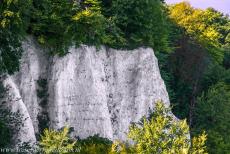
Jasmund National Park: The Feuerregenfelsen, the Fire Rain Rock, a cliff in the Stubbenkammer area. Around 1850, a special attraction emerged: the fire rain. Burning piles of brushwood were thrown down from this cliff north of the King's Chair, creating a rain of fire that flowed down the cliff to the beach and the sea. This attraction gave the chalk cliff the name Feuerregenfelsen, by which it is still known today. But nevertheless, the King's Chair remained the main attraction on the island of Rügen.
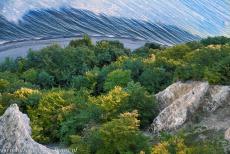
Jasmund National Park: The Hochuferweg is an approx.12 km long hiking trail, running through the national park, stretching from Lohme to Sassnitz. The route can be walked in sections or as a longer trek. The route meanders through ancient beech forests and along the top of the chalk cliffs, the cliffs range in height from 20 to 118 metres. The route leads past many of the sights in the national park. The Königsstuhl National Park Center is located along the route, here you can access a skywalk that provides views of the Königsstuhl. The centre features an exhibition about the ancient and primeval beech forests.
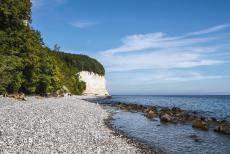
Jasmund National Park: The Piratenschlucht, the Pirate Bay. The white chalk cliffs on Rügen are formed by erosion from the wind and the sea, a process of millions of years. The erosion is still ongoing, causing pieces of rock to crumble and fall down, especially during heavy rainfall. Due to the erosion along the coast of Rügen, numerous fossils have been found, especially on the Jasmund peninsula. The national park is named after the Jasmund peninsula, where the park is located. The Jasmund National Park protects a portion the last remaining ancient and primeval beech forests of Europe.

Ancient beech forests of Germany: A lake in Serrahn, surrounded by peaceful ancient beech woodland. There are about 100 lakes in the park, and many wetland areas and brooks. Serrahn is part of the Müritz National Park in Germany. The park is a haven for birds, such as common cranes and white storks. White-tailed sea eagles and Ospreys breed in the park. The numerous lakes in the national park are used by migratory ducks. The red deer is common in the park. There are several bird watching trails in the park.
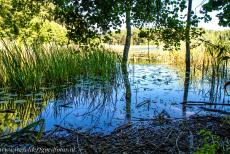
Müritz National Park in Germany: The remnants of several beeches floating on a swampy lake. There are about hundred lakes in the national park, most of the lakes are surrounded by reed belts. The park contains one of the last remaining parts of the ancient beech forests, that once covered a large part of Europe. The Ancient Beech Forests of Germany were inscribed on the UNESCO World Heritage List in 2011.

Müritz National Park: Serrahn is the most eastern part of the Müritz National Park. The park is separated in two areas, Müritz and Serrahn. Serrahn contains some of the oldest beeches, the Fagus sylvatica. Only Serrahn is part of the UNESCO World Heritage: Primeval Beech Forests of the Carpathians and other regions in Europe. Müritz National Park is famous for its vast forests, numerous lakes, moors and swamps.
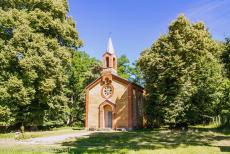
Müritz National Park: The Church of Speck was built in 1876-1877. The small village of Speck is situated in Müritz National Park, west of Serrahn, the eastern part of Müritz National Park. The village is surrounded by ancient beech forests. National Park Müritz is renowned for its well preserved ancient beech forests. The national park is located in Mecklenburg-West-Pomerania, a federal state in the northeast of Germany.

Primeval Beech Forests of the Carpathians and other regions in Europe: Lake Müritz in Müritz National Park, one of the largest national park of Germany. Lake Müritz is the second largest lake in Germany, after Lake Constance. The Nature Discovery Center Müritzeum is the visitor centre for the park, it is situated on Lake Müritz, near the town of Waren. The highlight of the Müritzeum is a huge aquarium, the largest aquarium for fresh water fish in Germany.

National Park of Kellerwald-Edersee is the first national park of Hessen. The park contains one of the last remaining parts of the ancient beech forests of Germany. The ancient beech forests are essential to understanding the history and evolution of the common beech, Fagus sylvatica. The ancient beech forests also holds the largest, the tallest and oldest beeches in the world. The Ancient Beech Forests of Germany gained the status as a UNESCO World Heritage in 2011.

The Forest Church on the Kellerwald Forest Trail. The National Park Kellerwald-Edersee in Hesse contains one of the ancient beech forests of Germany. One of the last large and complete beech woods is protected in the park. Natural forests, streamlets, meadows, and scree slopes form a unique ensemble. The National Park Kellerwald-Edersee is part of the UNESCO World Heritage: Primeval Beech Forests of the Carpathians and other regions in Europe.

An age-old border marking along the Kellerwald Forest Trail. National Park Kellerwald-Edersee contains a part of the ancient beech forests of Germany and is also part of the transboundary UNESCO World Heritage Site: Primeval Beech Forests of the Carpathians and other regions in Europe. The site stretches over twelve European countries: Albania, Austria, Belgium, Bosnia and Herzegovina, Bulgaria, Czechia, Croatia, France, Germany, Italy, North-Macedonia, Poland, Romania, Slovakia, Spain Ukraine and Switzerland.

The primeval Beech Forests of the Carpathians and other regions in Europe: Several other tree species can also be found in the primeval beech forests, such as black pine, chestnut tree, holm oak and silver fir. The forest floor is rich with flowers and fern species. The ancient beech forests of Germany, the primeval beech forests of the Carpathians and other regions in Europe are the last remaining parts of a huge beech forest, that once covered most of Europe.

The primeval beech forests of the Carpathians and other regions in Europe are the remains of a large forest, that once covered a great part of Europe. The primeval beech forests of Germany are located in five national parks: Hainich in Thüringia, Grumsiner Forst in Brandenburg, Müritz National Park and Jasmund National Park in Mecklenburg-West-Pommerania, and National Park Kellerwald-Edersee in Hesse.
